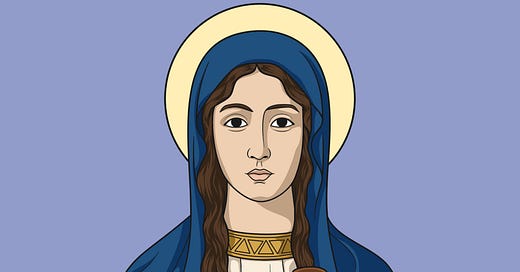Mary was a very common name in Jesus’ time, perhaps roughly equivalent with the names Karen and David when I was in primary school. In my class of twenty-eight kids there were five Davids and six Karens, which probably made it difficult for the teacher. There are at least four different Marys in the New Testament Gospels, and it is easy to muddle them up. There is Mary the mother of Jesus, Mary the sister of Lazarus whom Jesus brought back from the dead, Mary the wife of Clopas and mother of James, and Mary Magdalene.
In the Gospels Mary Magdalene is described as a follower of Jesus, and it is also mentioned that he had cast seven demons out of her. She was among the group of women who stood by the cross as Jesus died and she was the one to whom the risen Christ appeared on the first Easter Day; the first witness of the resurrection. In the Christian story, her presence in the resurrection account has made her a key figure. Perhaps this is why there is much speculation about her and her life; certainly not much was recorded in the gospels about her personally.
For many years in popular tradition Mary Magdalene was associated with another gospel story in which a woman described as a ‘sinner’ (a euphemism for a prostitute) came to Jesus to anoint him with oil before his death. Recent scholarship rejects the theory that the woman who anointed Jesus with oil was Mary Magdalene, but such stories never really go away. Feminist scholars point out that the woman who anointed Jesus in Luke 7 is unnamed, but if she were Mary Magdalene her name would have been noted, because Mary was so well known to early Christians. But despite this piece of logic, the Mary as prostitute story hangs on. It was given a central place on stage and screen in Andrew Lloyd Webber and Timothy Rice’s early 70’s musical Jesus Christ Superstar, in Frank Zeffirelli’s film Jesus of Nazareth, and as recently as 2003 in Martin Scorsese’s film version of The Last Temptation of Christ. 2003 also saw the release of Dan Brown’s bestselling novel The Da Vinci Code, made into an equally successful movie three years later. Dan Brown’s story tapped into an old legend that Mary Magdalene was Jesus’ girlfriend and the mother of his child. While one has to commend Dan Brown on a most entertaining ‘ripping yarn’, there is no more historical precedent for Mary Magdalene being Jesus’ lover as for her being a prostitute. What both stories betray is an unwillingness to focus on Mary as a Christian leader, a faithful witness of the resurrection and an apostle of the Church in her own right, in favour of taking an unhealthy, and probably very misguided, interest in her sex life.
Mary Magdalene has had her own feast day (now July 22) in the church since at least the 8th century. In Christian art she is usually shown holding a pot of ointment, a link with that prostitute story, or she is better shown in Gospel scenes of the crucifixion and resurrection where she properly fits. It is pretty clear that she has been unfairly and somewhat salaciously depicted over the centuries, but her designation in the Church as the patron saint both of repentant sinners and the contemplative life is happily a little more generous.
In the light of all this, it is perhaps no surprise that the lectionary readings for the Feast Day of St Mary Magdalene tap into many of the themes that have made the Church uncomfortable over the centuries: femininity, longing, death, tears. Each is associated with the physical reality of being a person. In the resurrection account in John’s gospel, we are well and truly in the realm of the material and physical. It recognises that in faith, as in all of life, we are physical beings. It is the quintessential Christian story in the New Testament; it is also the quintessential Mary Magdalene story. The human, physical nature of the narrative is palpable. A quick scan reveals an action packed account. Mary is up early. Predawn sees her walking quickly to Jesus’ tomb. Seeing that the stone had been removed, she runs. Mary weeps, she bends down, looking intently, she turns, she sees, she speaks, she hears… She hears Jesus’ voice… and she wants to hold him because now she knows… and she goes, she announces… she tells the others what she has experienced, what she now knows.
Biblical scholar Francis J Maloney suggests that, along with proclaiming the risen Christ, the writer of John provides us with a snapshot of Mary’s relationship with God coming full circle. It moves from the weeping darkness of unfaith, through the conditional faith that recognises Jesus merely as ‘rabbi’, to the messenger of faith who announces Jesus’ words to the other disciples. Through her experience on that resurrection day Mary is transformed. Rather than speculating about Mary’s sexual history, we are better served by focusing on her as a foundational character from the very earliest Christian community who journeyed from unfaith, through partial faith, into perfect understanding. She is, in fact, more appropriately remembered as the ‘apostle to the apostles’, in partnership with Jesus in the proclamation of Easter faith, than in any other manner.
Mary Magdalene is a genuine icon for the potential of faith in God, because she has become an exemplar of the kind of transformative faith that celebrates rather than denies the place of the material and physical in sacred experience. Despite having been made something of a scapegoat for a range of Christian insecurities about human physicality, sex, and gender over the centuries, in fact because of this, she is an important reminder. She is a reminder that we are, all of us, old and young, female and male, straight and gay, of all races and places and genders, real and bodily people who each day, minute, second, experience real bodily life with all its longings, fears, hopes, hungers, thirsts, and joys. Mary reminds us that the resurrection of Jesus Christ from the dead to which she bore witness is a transformative call to all of us to fully embody our faith, our hope, and our love. To live, breathe, and experience it in every aspect of our lives, and in all our relationships.
So let’s pray:
Gracious God, we are our own human selves. We live in our bodies with our own sense of touch and taste, of sight and smell; we feel, and think, and wonder. Grant us to know it is this humanity, this we share with Jesus, that equips us to be transformed in your love. Remind us, whatever our race, or gender, or culture, whatever it is that informs our being, you reach out to us all in loving embrace. Give us eyes to see, ears to hear, and hearts to know the sacred astonishment and joy of Mary Magdalene as she recognised you in the risen Christ. By your Spirit, resurrect in us desire to voice our faith, to carry our love, to weep our hope and so be apostles of Christ. Like Mary, enable us to embody your gospel with our entire selves. We pray in Jesus’ name, Amen.
Rev Dr Eleanor O’Donnell is the Director of Anglican Identity at the Anglican Schools Commission Inc. based in Perth, Western Australia. She is an Anglican priest with a background in school chaplaincy, and a qualified teacher. She earned her PhD on the nexus between Trinitarian and Process Theology from St Mark’s National Theological Centre (Charles Sturt University) in Canberra. She is the author of The Relational Power of God: Considering the Rebel Voice (Pickwick Publications, 2023) and has a keen interest in contemporary theology, especially as it informs power and gender.
Click for more of Mary Magdalene in the Faith of Our Mothers Series.







Thank you so much Eleanor!